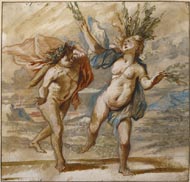|
The Baroque Age was one of the most creative periods in Western art. From the late 16th century through the end of the 17th century, artists of extraordinary talent emerged across Europe, particularly in Italy, France, Flanders, and Holland.
Drawing flourished as an art form during the Baroque period. Artists experimented with exuberant color, dramatic imagery, and strong contrasts of light and shade. They explored new approaches to subject matter including allegory, rustic scenes, and religious themes of the Counter-Reformation.
|
 |
|
Inspired by classical sculpture and recent advances in anatomical study, Baroque artists made great strides in the naturalistic portrayal of bodies in motion. Such motion creates a sense of drama and often reflects physical or emotional strife. Artists enlivened their compositions by using twisting poses and dramatic foreshortening, or projection into space.
In the drawing above, Peter Paul Rubens presents anatomical sketches of a flayed male figure from three different vantage points. The subject's exaggerated musculature and lunging pose convey great physicality and energy.
|
 |

 |
 |
Apollo and Daphne, Jan Boeckhorst, about 1640
Recent Acquisition
|
 |
 |
Many 17th-century draftsmen used not only pen or chalk but also watercolor (transparent water-soluble color), gouache (opaque water-soluble color), and even oil paint. These media allowed artists to achieve forms that are more vibrant and freely drawn.
Jan Boeckhorst's colorful work blurs the boundaries between drawing and painting. This mythological scene, based on an ancient tale from Ovid, depicts Daphne turning into a laurel tree in order to avoid the advances of the love-struck god Apollo. The artist drew from life, making his Apollo and Daphne a celebration of robustness and fecundity.
|
 |
|
Chiaroscuro, the use of varying tones to imitate light and shadow, originated in the early Renaissance as a means to create volume for individual forms. Baroque artists also applied the concept of chiaroscuro to their compositions overall, using light and dark areas to create theatrically and emotional energy.
Dutch artist Nikolaus Knüpfer used chiaroscuro to great effect in this monumental drawing of Pilate washing his hands after the crowd's decision to crucify Christ. White highlights on Christ's chest draw attention to him and his vulnerability. The darkened backs of the foreground figures and the low vantage point intensify the drama and make the viewer feel like part of the crowd.
|
 |
|
Landscape became a subject in its own right during the 17th century. Artists depicted casual scenes such as a sunny glade or a bend in the road as well as the famous monuments and ruins of ancient Rome. They strove for naturalistic effects such as dappled sunlight and the motion of wind through leafy trees.
The ruins and gardens at Tivoli were among Claude Lorrain's favorite subjects. Here he used ink washes to create shimmering effects of light and shadow. The travelers on the path in the foreground seem to invite viewers to embark on a visual journey through the countryside.
|
 |
|
Art played a critical role in the Counter-Reformation and was used by the Catholic Church to reinspire worshippers following the Protestant Reformation. The Church commissioned artists to create works that would stimulate religious fervor.
In this crucifixion scene, Pietro da Cortona brings the divine within the realm of human experience by portraying extreme suffering and grief. The Virgin and Saint John fix their gaze on the suffering Jesus while Mary Magdalene kisses his feet. Jesus' heavenward gaze and open mouth evoke the moment when he cried out, "My God, my God, why hast thou forsaken me?"
|
 |
|
Allegories are stories or pictures that employ symbols to convey hidden meanings. Artists of the 17th century often used human figures, animals, and objects as symbols of abstract concepts.
In this drawing by Carlo Maratti, created in honor of Pope Innocent XI, allegorical figures give human form to the concepts of justice (left) and faith (right). Faith is linked to the pope by her papal attributes: the crosier (or staff), the model of the Church, and the tiara. She also holds keys to indicate spiritual authority. The white rays issuing from Faith's head reveal the primacy of Faith over Justice.
|
 |
|
Naturalistic depictions of daily life became popular in Europe, especially Holland, during the 17th century. Certain figures, poses, settings, and subjects appeared frequently, establishing a set of rustic types and themes.
Herman Saftleven the Younger's portrayal of a young herdsman conveys the boy's poverty and his quiet dignity. His billowing garment, oversized shoes, and tattered hat poignantly overwhelm his diminutive form. The houlette, a tool used for digging up clods of dirt to throw at the animals to guide them in the desired direction, contributes to the rustic effect.
|
 |